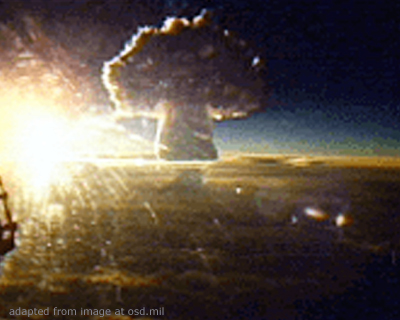Satellite Imagery Points To Uptick In Activity At Russian Arctic Nuclear Testing Site
Russia has significantly increased construction at a remote Arctic island location where Soviet nuclear tests were conducted, new satellite imagery shows, suggesting Moscow may be intending to resume tests.
Annotated images obtained by the Middlebury Institute for International Studies and shared with RFE/RL showed a number of new facilities and construction equipment on Novaya Zemlya, an island archipelago located in the northern Barents Sea.
The images were released as part of a report examining the uptick in construction at nuclear test sites not only in Russia, but also in the United States and China. Details of the report were published earlier by CNN.
A comparison of imagery taken in July 2021 and in June 2023, showed large trucks, shipping containers, construction cranes, and building supplies at a settlement in Novaya Zemlya called Severny, according to the analysis by the Middlebury Institute, located in Monterey, California.
The activity appears to be aimed at least two new buildings, including what will be the location's largest.
Such a pace of construction at the site has not been seen "since the end of nuclear testing in the 1990s," the institute said, and may indicate Russia plans to expand personnel there or operate it year-round.
The archipelago was used by the Soviets for years of Cold War nuclear testing, including the detonation of the most powerful device ever constructed, the Tsar Bomba, in 1961. A 2004 research paper estimated 224 nuclear detonations on the islands until 1990, when Moscow conducted its last.
Russia and the United States later announced a moratorium on all nuclear tests, and both signed the 1996 Comprehensive Nuclear Test Ban. However, the treaty has not come into effect, since the minimum number of countries required to ratify it has not been reached. Russia ratified the treaty in 2000; the United States has yet to do so.
Novaya Zemlya has been the focus of new, heightened attention from analysts and open-source researchers in recent years, in particular after a 2019 incident in the White Sea, where, according to U.S. officials, a nuclear-powered missile called the Burevestnik exploded accidentally, spewing radiation over long distances, including a nearby Russian city.
In the months after the blast, satellite imagery and other data -- including warnings issued to airlines about airspace closure in the Barents Sea -- suggested Russia might be seeking to move testing of the Burevestnik missile to another location on Novaya Zemlya, a site called Pankovo.
Within the past month, meanwhile, other researchers have detected new activity at the suspected Pankovo test site, along with airspace and maritime warnings. Open-source researchers Bellingcat released a new image of the site dated September 20.
Hints that Russia might be preparing to resume nuclear testing come as other nuclear powers, including the United States and China, have also signaled intentions, overtly or covertly, to do the same.
In 2019, under the administration of then-President Donald Trump, some U.S. officials reportedly pushed to resume full testing. The official U.S. policy statement on the subject -- the Nuclear Posture Review -- ultimately stated that the United States would not seek to ratify the test-ban treaty, and it would "remain ready to resume nuclear testing if necessary to meet severe technological or geopolitical challenges."
Middlebury researchers contrasted the imagery at Novaya Zemlya with imagery from a U.S. test site in Nevada, where, they said, U.S. officials have conducted mining operations to add more than 1,000 square feet of underground laboratory space. That could be an indication the United States intends to conduct new subcritical nuclear experiments -- tests that are allowed under the test-ban treaty.
China has also expanded construction in recent years at Lop Nor, a known nuclear testing site in the western Xinjiang Province, Middlebury researchers found.
"A resumption of nuclear explosive testing by the three big nuclear powers would allow all three to resume development of new nuclear weapons and accelerate the arms race among the three," they said.
[please be sure to consider clicking the support button, to support this web project and related efforts]
Key Words: Russia, Nuclear, Nuclear Testing, Arctic
